Halifax W1235 at Wombleton airfield.
On 3rd June 1944 this 1666 Heavy Conversion Unit aircraft was being flown on a basic circuits and landings exercise at Wombleton airfield. At 15.22hrs during one of the landings the aircraft bounced twice and then floated off the end of the runway. The pilot attempted to apply power to overshoot and climb away but the aircraft had lost flying speed and it crashed into a field just off the end of the runway. The undercarriage collapsed and it came to a halt badly damaged. I have not yet located which runway the aircraft was landing on or which field the crash occurred in. The crew list shown below is one I have worked out based on their postings in and out of 1666 H.C.U. shown in the unit record book but on this date it remains unconfirmed.
Halifax W1235 was built to contract B73328/40 by Handley Page Ltd at Radlett and was delivered to 460 Squadron at Breighton in July 1942. The unit converted to Lancasters in September 1942 and the aircraft passed into MU storagee for a short period before being issued to 419 Squadron at Middleton St.George in November 1942. It served operationally with them until being the third aircraft issued to 1666 H.C.U. after it formed and it arrived with 1666 H.C.U. on 10th July 1943. It was written off following this incident detailed above with Cat.E2/FA damage being the damage assessment.
Pilot - F/O Frederick Winston How RCAF (J/17469), of Edmonton, Alberta, Canada.
Navigator - (probably) F/O Victor Zoratti RCAF (J/35036), of Winnipeg, Manitoba, Canada.
Bomb Aimer - Sgt John Alfred Stuart MacGregor RCAF (R/148448), of Martintown, Ontario, Canada.
Wireless Operator / Air Gunner - F/Sgt Cecil David Benjamin Hubley RCAF (R/134220), of Manitou, Manitoba, Canada.
Rear Gunner - Sgt Norman Ray Springstein RCAF (R/196792), of Merid, Saskatchewan, Canada.
Mid Upper Gunner - Sgt Cecil Ralph Tait RCAF (R/207980), of Rapides des Joachims, Quebec, Canada.
Flight Engineer - Sgt Leslie William Foster RAFVR (1891150) OR Sgt Joseph Atkinson RAF (613970).
Back Row - Fred How. Middle Row - Cecil Hubley, Victor Zoratti and Cecil Tait. Front Row - Norman Springstein, Alfred MacGregor. This photograph was probably taken at OTU prior to joining with a flight engineer and was found on "www.veterans.gc.ca" but incorrectly names many of the crew. This crew's regular navigator when they arrived at 1666 H.C.U. on 22nd May 1944 was Victor Zoratti and was almost certainly flying in Halifax W1235 when it crashed at Wombleton a few days later on 3rd June 1944. F/O Zoratti was killed while flying as a second navigator with another crew on 11th July 1944 in the crash of Halifax HX147 near York. He appears to have been replaced by Russell Nickle.
After completing their training at 1666 H.C.U. this crew were posted out to an operational squadron, at that time the navigator was P/O Russell Karl Nickle RCAF (J/29618) and the flight engineer was Sgt Joseph Atkinson RAF (613970). They arrived at 419 Squadron on 31st August 1944 as a seven man crew. On 27th / 28th December 1944 How, Nickle, Atkinson, MacGregor, Hubley, Sprinstein and Tait were flying Lancaster KB738 "D-Dorothy" on Ops to Opladen when the aircraft crashed in Germany killing all on board. They are now buried in Rheinberg War Cemetery, Germany. How was aged 22, Nickle was 27, MacGregor 26, Hubley and Tait 20 and Springstein 19. My thanks to Mr Graham Sharpe for the photographs of their gravestones.
Frederick How was born on 5th December 1922 in Edmonton, Alberta, Canada and was the son of Arthur Langley and Ada Annie (nee Crockett) How. He was still at high school when he enlisted for RCAF service in Edmonton on 5th May 1941, he trained as a pilot gaining his pilot's flying badge on 2nd January 1942. He was then posted to the UK and would serve at 1517 B.A.T.Flight and No.6 (P)AFU where he was probably served as a staff pilot at both these units. He received a commission on 1st April 1943. On 1st February 1944 he was posted to 82 OTU and then later to 1666 HCU on 22nd May 1944. With Bomber Command training complete he was posted to 419 Squadron on 31st August 1944.
John MacGregor was born on 3rd May 1918 at Fournier, near Riceville, Ontario, Canada and was the son of Charles and Elsie (nee Muir) MacGregor. His family soon moved to Martintown, Ontario and when he left school in 1935 he begun working as a farm worker on a family farm. He enlisted for RCAF service in Montreal on 19th January 1942 and after training in Canada he was awarded his Air Observer's Badge on 26th June 1943 and left for service overseas soon after. On arrival in the UK he was posted to 3 (O)AFU to train followed by a posting to 82 OTU on 14th September 1943. On 12th October 1943 he was about to fly a training flight in Wellington HE201 which suffered engine failure on take off from Ossington, the aircraft failed to gain height and eventually crash landed near Bevercotes and three of the crew were killed in the resulting crash and fire. He sustained burns to his hands and face and leg and was admitted to RAF Hospital Rauceby and while there he received a commission on 10th November 1944. He sustained serious injuries as a result of this accident and took some months to recover, he left Rauceby in mid-November 1943 and was posted back to 82 OTU to recover but appears to have spent many months there though eventually completed his OTU training. On 22nd May 1944 he was posted to 1666 HCU and then to 419 Squadron on 31st August 1944.
Cecil Hubley was born on 22nd March 1923 and was the son of James Dimmoc and Jeanne Barnett (nee Duncan) Hubley, of Manitou, Manitoba, Canada. When he left school he began working for his father on the family farm. He enlisted for RCAF service on 27th September 1941 in Winnipeg and trained as a wireless operator / air gunner in Canada before being awarded his Air Gunner's badge on 22nd February 1943. He arrived in the UK in November 1943 and then trained at 6 (O)AFU and 82 OTU before posting to 1666 HCU at Wombleton on 22nd May 1944. He and his crew were posted to 419 Squadron on 31st August 1944 and he received a commission on 13th November 1944.
Norman Springstein was born on 4th January 1925 at Kerrobert, Saskatcehwan, Canada and was the son of Archibald Peter and Margaret Ella (nee Wilson) Springstein. The family later moved to Merid, Saskatchewan. His father had served in WW1 and the family were working in farming. he enlisted for RCAF service on 15th December 1942 and after training in Canada he was awarded his air gunner's flying badge and also a commission on 12th November 1943. Norman had two brothers who also served in the Canadian Forces in WW2. Springstein Lake in Saskatchewan is named in his honour.
Cecil Tait was born on 27th April 1924 at Pembroke, Ontario, Canada and was the son of Thomas and Alice Malinda (nee Duke) Tait. After leaving school in 1940 he worked as a postmaetr's assistant for three years until being unemployed and returning home to assist his father scaling (fish?). He enlisted for RCAF service on 17th February 1943 at Ottawa and after training received his air gunner's flying badge on 12th November 1943.He arrived in the UK by the end of 1943 and would train at 82 OTU before posting to 1666 HCU on 22nd May 1944. He was posted to 419 Squadron on 31st August 1944. He and Norman Springstein may have met in Canada prior to arriving in the UK.
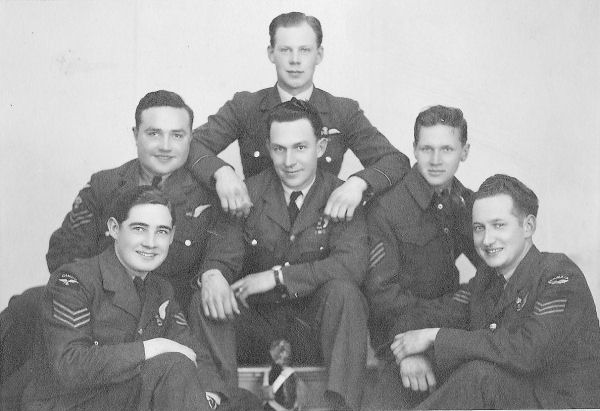
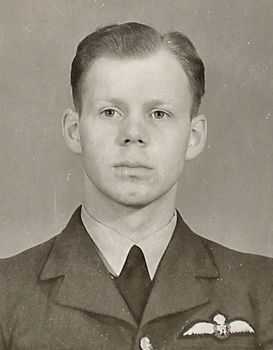
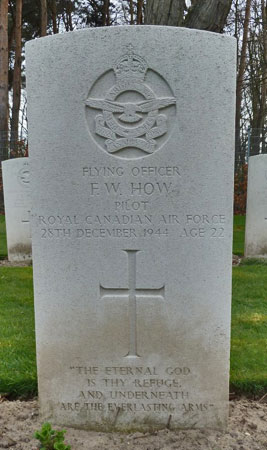
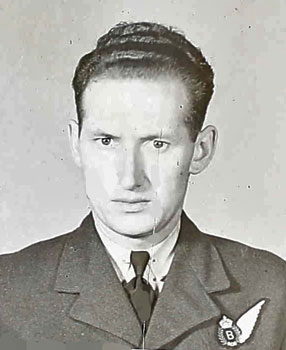
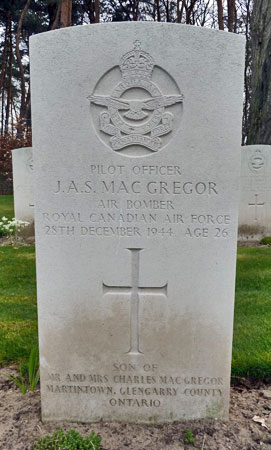
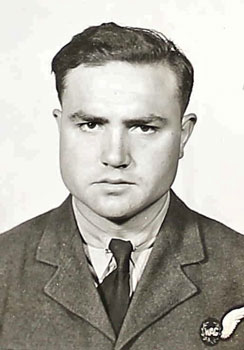
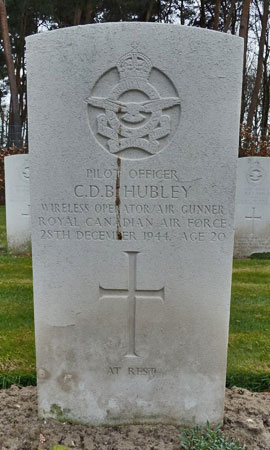

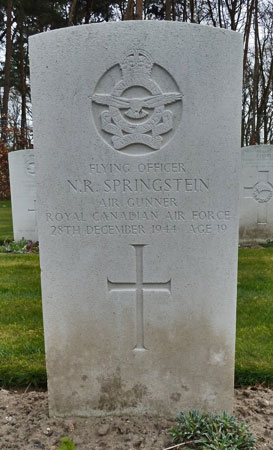
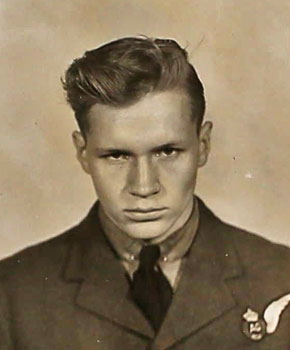
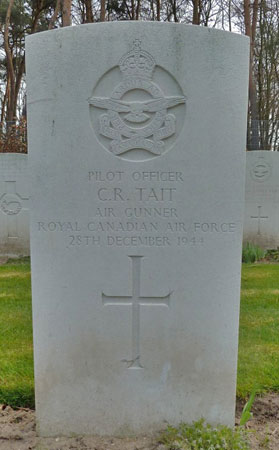
I can't remember where I got the suggested flight engineer Leslie Foster's name from but if he was in How's crew in June 1944 then later received a commission and having survived the War remained in the RAF until 1959.